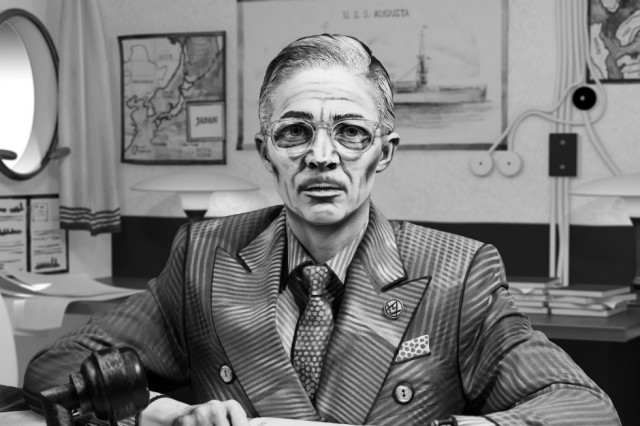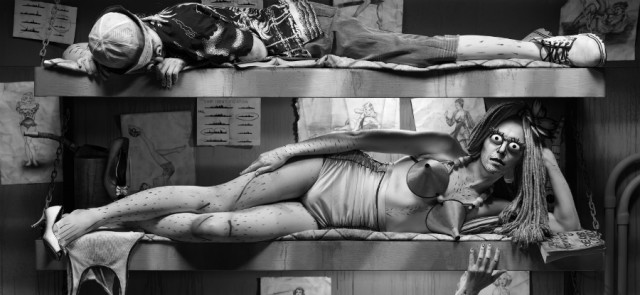Mary Reid Kelley And Patrick Kelley: We Are Ghosts
Lauren Barnes, Assistant Curator at Tate Liverpool, tells us how the cartoon-like characters, bawdy sense of humour, and handmade props and sets of artists Mary Reid Kelley and Patrick Kelley correct, complicate and retell existing narratives…
When I first came across the films of Mary Reid Kelley and Patrick Kelley two years ago in a group exhibition, I was transfixed. Here was a work whose black and white palette and highly structured poetic language gave the fleeting suggestion of a historical artefact, an impression that was simultaneously undercut by its cartoon-like characters, playful mixing of different periods and elaborate digital editing techniques.
On screen, a lycra-clad female Minotaur with a brown bag over her head lamented her confinement as she paced around the labyrinth. The film was Priapus Agonistes 2013, a re-telling of the Greek myth of the Minotaur that included, among other things, a 1970s volleyball match and a particularly bitchy pun-filled conversation between a swim-suited Pasiphae and dog-faced Venus.
I have followed Mary and Patrick’s work since that first encounter, and have continued to be fascinated by the complex and hugely entertaining ways that they deal with the afterlives of historical and mythical figures. Whether set in 19th century Paris or a First World War field hospital, their films combine a commitment to research with an often bawdy sense of humour, and a nuanced amalgamation of handmade and digital elements. Working collaboratively, Mary writes the films’ scripts and creates the make-up, costumes, set drawings and props, while Patrick co-directs, films, creates digital sets and edits.

The exhibition’s title, We Are Ghosts, draws attention to the fundamental concern that connects the two films it includes. Both This Is Offal (2016) and In The Body of The Sturgeon (2017) are ghost stories of sorts, tales that bring the dead back to life to tell alternative versions of events. This is Offal is both homage and riposte to Thomas Hood’s 1844 poem The Bridge of Sighs, whose drowned heroine is not afforded a voice. The film’s subject is an unnamed woman who has committed suicide by jumping off a bridge into a river, whose ghost, alongside her internal organs and body parts, engage in a spirited discussion as to the meaning of their life and afterlife, and argue over whose fault it was that she jumped in the first place: brain, heart, liver, foot and hand all say their piece.
For In The Body of The Sturgeon, the new, co-commissioned film, the artists focus on the crew of a US submarine – the fictional U.S.S. Sturgeon – during the Second World War, conjuring the claustrophobia and isolation of this very particular environment, imagining the moment at which this young crew heard the news of the US bombing of Hiroshima, and finally recording their slow death by suffocation.

The script is a cento, or collage, of the American poet Henry Wadsworth Longfellow’s epic The Song of Hiawatha (1855), a much-parodied assemblage of Native American folklore that attempted to create a bucolic origin myth for the United States. In The Body of the Sturgeon uses the language and distinctive poetic structure of Longfellow’s poem to tell another formative episode in US history, and in so doing calls attention to the acts of translation and appropriation that define the way those stories are told.
These works are united by their efforts of recuperation, drawing attention to the translation of events that constitute history and fiction. The title of the exhibition, We Are Ghosts, therefore feels like a description of Mary and Patrick themselves, standing in for ghosts of the past in their films, appearing somehow uncannily out of time to correct, complicate and retell existing narratives.
Lauren Barnes
This essay is taken from Tate Liverpool’s new seasonal publication Compass. Available for £1, exclusively at Tate Liverpool, it features articles and essays exploring exhibitions on each floor of the gallery
See Mary Reid Kelley and Patrick Kelley: We Are Ghosts at Tate Liverpool until 18 March 2018 — FREE entry
See more from the artists on their website
Images courtesy Mary Reid Kelley and Patrick Kelley and Pilar Corrias, London. From top: a live performance of This Is Offal (2016) at BMW Tate Live (2015); Harry S. Truman (2017); Gaudy Night (2017)





